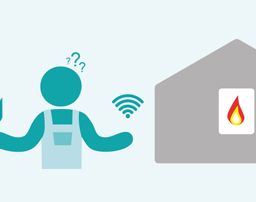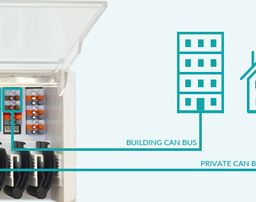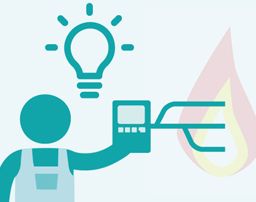Alexa, smartphone and co: Opportunities and Limitations for the Heating Industry
Reading time: 9 min

The smartphone has undoubtedly become an all-purpose weapon over the last decade, with a penetration rate of around 97% among the working-age population[1]. Building on the success of the smartphone, other connected consumer electronics have made a breakthrough as well. These have become so influential in our everyday lives that hardly any area remains untouched by them.
For manufacturers in the heating industry, too, the question increasingly arises as to how the expectations shaped by consumer electronics are reflected in their products or how they can relate to each other.
The heating industry may not always be at the forefront of the application of digital technologies. Nevertheless, it now offers numerous apps for installers or end customers and more and more heating systems are going online.
The article “How connectivity shapes the future of HVAC” explains the underlying trends for this development.
The suitability of the smartphone as a control device for heating systems

Apps are often used to provide installers with information on the use of their products, to process orders logistically or as tools for after-sales service. In many cases, the smartphone is also a complement to the actual operating device of a heating or cooling system.
Since almost everyone is proficient in using a smartphone, the idea of moving part or all of the user interface of a heating system to the smartphone comes naturally. For example, to replace wall thermostats in the living room or on radiators, or if a service-led setup is desired instead of a device-led setup (see “UX for connected heating and cooling systems“).
The advantages are savings on hardware costs and possibly a modern image. However, there are various limitations to consider when using the smartphone as the main operating device for heating systems:
- In addition to the system owner, heating installers in particular need uncomplicated and quick access to the entire system during commissioning and service visits. However, downloading an app and setting up access to the respective system add further work steps. Poor mobile reception in the boiler room or the lack of a smartphone that can be used on duty can be further practical hurdles.
- Limits the usability of the system in public spaces, for example in hotels or offices, but also in guest rooms. Distributing temporary access rights to ever changing room users or requiring the downloading and activation of an app in order to adjust the room temperature seems inconvenient.
- The power of habit. For example, someone who has memorised all his life that the room temperature has to be adjusted by going to the radiator or the wall thermostat would have to make a mental effort to establish a new sequence of actions by reaching for the smartphone instead (see info box: mental model). Not everyone is willing to make this “effort”, even if it may seem trivial to the developing technicians. Why else are there still remote controls 10 years after the introduction of smart TVs? As engineers and tinkerers, product developers sometimes overestimate the willingness of craftsmen and end customers to want to learn new procedures. Product developers should at least take this into account before they exclude some customer segments with an overly radical shift to app-based operating concepts.
A healthy middle ground could be to offer the operation via smartphone app to the customer as an option and thus leave the choice to the respective customer’s wish or use case.
Infobox: mentales Modell
In psychology, the idea in a person’s head of how something should work is called a mental model. For example, for making appointments, the use of calendars is a prevalent mental model.
Using a product against the intuition of a mental model requires a cognitive learning effort that most people like to avoid. Mental models are often very persistent over time.
In interaction design, therefore, in order to optimise usability, it is usually attempted to align product use with the user’s mental models rather than vice versa.
Voice assistants in heating technology
 29% of UK households owned a smart speaker such as the Amazon Echo in 2020[2].
29% of UK households owned a smart speaker such as the Amazon Echo in 2020[2].
Technically mature Natural Language Processing (NLP) has the great advantage of using the most natural and thus most convenient of all human communication channels. From a usability point of view, this is initially very interesting. However, there are also many limitations in general and for the heating industry in particular:
- As respectable as it may be technically to train a voice assistant’s AI (artificial intelligence) to correctly understand 95% or even 99% of commands, the remaining 5% or 1% make for the most memorable moments for the user and can quickly turn the fun of the technology into frustration. Microsoft’s speech recognition Cortana recently beat professional stenographers in speech recognition – but under laboratory conditions. However, background noise and the AI’s lack of context awareness still cause noticeable comprehension problems in real-life situations.
- Artificial language quickly loses its natural sound outside the English-speaking world. For one thing, the focus of developers is on the English-speaking world due to the dominance of Silicon Valley technology, and English is also grammatically much simpler than most other languages. For German, Italian or Spanish, voice assistants will certainly also make rapid progress. However, due to the law of diminishing marginal utility – the relationship between effort and progress achieved flattens out – it may still take many years to develop the last % of necessary language depth that is ultimately needed for truly natural communication without frustrating individual experiences.
- Conflicts of meaning between the voice assistant and the actual heating system. Example: when Alexa “increases the heating by 1°C”, does it mean a temporary or permanent increase? Does it refer to the current room, the whole house or even the set flow temperature? What does Alexa mean by a “holiday mode” or a “setback temperature”? For all these subtleties, a modus operandi must be found that allows the heating system to run efficiently and does not confuse the user with contradictory behaviour. Otherwise, if the heating reacts differently than the user expects with his voice commands, the heating system will get the blame in the end.
- Lack of feedback. A voice assistant can confirm that it has sent a command to increase the temperature. However, it is more difficult to know whether the receiver side (the heating system) has also received, understood and executed this command. Perhaps the heat source is outside its set operating hours, a protective function blocks the temperature increase, or the receiver side is not online at all.
- Pace. Heating systems have longer development times and a longer life cycle. Consumer electronics, on the other hand, are extremely fast-moving – technical innovations appear on the market in quick succession and become obsolete just as quickly. While the heating industry is busy trying to make its systems compatible with the latest voice assistants, Silicon Valley may already have the next big thing on the way and everything is starting all over again. In some areas, the pressure of demand from the end customer will leave heating manufacturers with little choice. In many product classes and application areas of heating technology, however, there remains some freedom for product management to decide whether and to what extent they want to expose themselves to this balancing act between two different worlds.
- Voice assistants are interesting for standardisable commands, but not for complex inputs or queries. This is all the more true to the extent that technical jargon comes into play, for which machine learning has only a fraction of the usual training data available. Thus, a voice assistant cannot do expert-level system parameterisation, set up a time programme by the end customer or query more comprehensive energy statistics, so they will probably be limited to the role of secondary interface for a long time to come.
- Costs for the manufacturers: Handling two interfaces (one verbal, one tactile) has to be paid for and means not only higher development costs but also a higher potential for errors. Be it in the product or also through potential misunderstandings on the user side.
How digital companies are becoming competitors for the heating industry

The innovations of tech giants like Amazon, Apple or Google undoubtedly bring exciting opportunities to make heating technology more modern, efficient and user-friendly. However, the relationship between heating technology and consumer electronics also holds potential for tension.
On the one hand, Silicon Valley is shaping consumer expectations in such a way that the product development of heating technology is increasingly driven by decisions made by Big Tech. Moreover, this is happening at a rapid pace and challenges the development speed of heating technology to keep up.
Ignoring deeply held customer wishes is certainly not the right answer. But even if one’s own product development is condemned to follow whatever consumer electronics comes up with, our industry can at least choose not to push this harder than necessary, and defend at least some of our own interests.
Secondly, digital companies from outside the industry are becoming competitors for customer access. They all focus on collecting data, learning user behaviour and thereby gaining more and more influence in the buying decisions of their and ultimately our industry’s customers.
With “Amazon Business”, the American near-monopolist is already pushing its way into B2B supply chains, including the three-stage distribution of the heating industry, or is marketing its own branded products coming close to building technology.
Google also moved into hardware manufacturing years ago with Nest, serving some heating applications itself. With its dominant search engine, Google also has a powerful lever to control the flow of visitors on the internet according to its own criteria. The Google algorithm strongly determines which websites are visited by building services planners or potential heating retrofitters and which are not. This is not new, but what comes next?
Similar to how they have already driven many other industries into great dependency by cleverly playing out their market power, Amazon and Co could also tip the balance of power in the heating industry and slowly degrade HVAC manufacturers to interchangeable sub-suppliers.
In addition to the established consumer electronics manufacturers, well-funded digital start-ups with strengths in data intelligence and addressing end customers could also prepare to expand their influence on purchasing decisions in heating technology at the expense of the traditional HVAC specialists. Smart thermostats, for example, often lure end customers with fine-sounding features and bold energy-saving promises. Although the trivial on-off switches behind them do not do justice to the complexity of the system technology, they secure access to system and customer data in order to control the lucrative business with service contracts and retrofitting.
Once customers choose their heating system by Amazon reviews and Google rankings, the question of compatibility with Alexa and smart home systems is asked before classic purchase criteria such as efficiency levels, manufacturing precision or longevity are discussed, or an order for a complex retrofit project is placed based on the automated recommendation of an algorithm from outside the industry, then the heating industry has lost a large piece of target group ownership.
In order to prevent this from happening, the heating industry must discover its own way of dealing with data intelligence instead of recklessly allowing itself to be harnessed as a data supplier for the digital corporations. How the heating industry can build up and use its own data intelligence is described in the chapter “New value propositions for heating technology in the IoT“.
[1] https://de.statista.com/statistik/daten/studie/459963/umfrage/anteil-der-smartphone-nutzer-in-deutschland-nach-altersgruppe/. Retrieved Nov 19th, 2020
[2] https://mobilemarketingmagazine.com/uk-smart-speaker-ownership-2020-gfk-techuk. Retrieved Feb 8th, 2021








